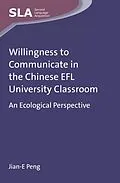This book presents mixed-methods research into Chinese students' willingness to communicate (WTC) in an EFL classroom context. The interrelationships between WTC and motivation, communication confidence, learner beliefs and classroom environment are examined using structural equation modelling on data collected in a large-scale survey. These results are then complemented and expanded upon in a follow-up multiple case-study that identifies six themes which account for fluctuations of WTC over time and across situations. The qualitative and quantitative data provide the grounds for the proposition of an ecological model of WTC in the Chinese EFL university classroom, which reveals that WTC is socioculturally constructed as a function of the interaction of individual and environmental factors inside and beyond the classroom walls.
Autorentext
Jian-E Peng is an Associate Professor at the College of Liberal Arts, Shantou University, China. Her research interests include willingness to communicate in an L2, learner motivation, intercultural communication, and research methodology. She has published in the journals of Language Learning, System, The Asia-Pacific Education Researcher and University of Sydney Papers in TESOL.
Inhalt
Part 1. The Research of Willingness to Communicate in a Second Language
1. Introduction
2. Hybrid Perspectives on WTC in an L2
Part 2. The Big Picture: Interrelationships between WTC, Communication Confidence, Motivation, Learner Beliefs, and Classroom Environment (Phase 1: Questionnaire Survey)
3. Dimensions of WTC, Confidence, Motivation, Beliefs, and Classroom Environment
4. Interrelationships between WTC, Confidence, Motivation, Beliefs, and Environment on WTC: A Full Structural Model
Part 3. A Situated Lens: WTC Fluctuations over Time and Across Classroom Situations (Phase 2: A Multiple-Case Study)
5. Four Cases and Their WTC Fluctuations
6. Distal and Proximal Influences on WTC Fluctuations
Part 4. Blending "Apple Juice" and "Orange Juice": Integration of Overall Findings
7. WTC Inside the Language Classroom and Beyond
8. Concluding Remarks
References
Appendix 1. Factor Loadings
Appendix 2. Questionnaire
Appendix 3. Correlation Matrix for the Structural Model
Appendix 4. Interview Guide
Appendix 5. Classroom Observation Scheme
Appendix 6. Learning Journal Framework
Appendix 7. Coding Scheme Index
